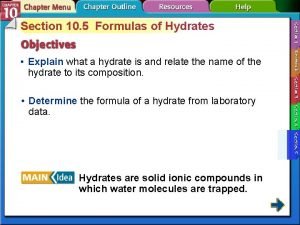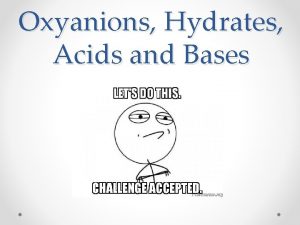Economical Potential of Stranded Natural Gas Hydrates John

- Slides: 1

Economical Potential of Stranded Natural Gas Hydrates* John Hudson**, Elizabeth Wyant**, Liu Shi and Miguel J. Bagajewicz University of Oklahoma ― Chemical Engineering *This work was done as part of the capstone Chemical Engineering class at the University of Oklahoma **Capstone undergraduate students Abstract This work studies the commercial feasibility of producing natural gas from Ng hydrates in the peninsula region of Kamchatka, Russia and selling it to markets in either China or Japan. A production model was constructed to determine the logistics of surface equipment placement. In addition, the difference in prices between transporting the produced natural gas via pipeline and tanker ship were compared. Preliminary calculations compare the commercial viability of constructing an LNG plant on the western coast of Kamchatka to selling gas to China via pipeline. Reservoir pressure model Tasks Have Logistic for both the LNG/ Pipeline started 1 Seismic: 5 person team (6 -8 weeks) Reservoir Pressure Flow Properties Dissociation Pressure Distance from well • Wiggins and Shah (OU) model (2001) • Based on continuity equation and Darcy flow. • Uses dissociation kinetics. • Consider pressure drop in porous hydrate free rock 2 3 4 5 6 7 8 9 10 11 -30 $54 Order Materials for Pipeline/LNG facility Find crew and begin measures to house and feed them Ship Intial Equipment: Build Pad 1 Drill 1 st Well, perform core analysis, and other analysis Cap well until Pipeline/LNGbuilding is completed Build Pipeline/LNG: will take 3 - 6 years (Assume 4 years) Start building facilities for each location (approx. 2 months per facility) Drill all other wells Start wells to sells Figure 5: Difference in costs of pipeline for varying flowrates and conditions. 25, 000 SCMD (0. 1 to 20 years) Table 1: Schedule of operations 750 700 Problem • Can gas hydrates be exploited economically? • What are hydrates and where are they located? • What research is going on and what are the problems? • What is the time line for the project? • Where are the wells going to be drilled and how many? • What kind of production can be expected? • What markets can the natural gas from hydrate be sold in? • What is the most economic option to transport the natural gas to the sales market? 600 550 500 Pressure, psi With the supply of conventional energy sources on a decline and the demand for them increasing, the need for a large and stable supply of unconventional resources is growing fast. Natural gas hydrates can be found on the ocean floor and in permafrost regions, such as Alaska, Siberia and eastern Russia 650 400 350 300 250 200 150 Figure 6: Total Gas-to-Liquids (GTL) costs for varying gas flow rates. 100 50 0 0 20000 40000 60000 80000 100000 Radius, m 120000 140000 160000 180000 Figure 1: Reservoir pressure profile for maximum flow rate before choke conditions occur. Figure 3: Difference in price for LNG equipment for varying selling rates. Maximum Flow Rate in Piping Pipeline Net Present Worth LNG Pipeline $3, 109 -$4, 437 130 $5, 126 -$1, 220 195 $5, 063 -$3, 399 195 $7, 951 $1, 310 260 $7, 040 -$2, 294 260 $10, 894 $3, 985 390 $10, 898 $545 390 $16, 673 $9, 963 Net Present Worth LNG 130 10. 0 Return On Investment 20. 54% 1. 90% 130 35. 89% 7. 92% 195 22. 26% 5. 60% 195 39. 84% 17. 02% 6. 0 260 22. 93% 9. 77% 260 41. 35% 21. 83% 5. 0 390 23. 86% 18. 76% 390 44. 05% 29. 80% Return On Investment 130 7. 0 8. 0 Billions Flow Rate, m 3/d 9. 0 Kamchatka Peninsula, Russia Horizontal Wells (2. 6 x 106 ft 3/d) Vertical Wells (883000 ft 3/d) 4. 0 3. 0 Conclusions 2. 0 1. 0 0. 0 1 2 3 4 5 6 7 Diameter, in 8 9 10 11 Figure 2: Natural gas flow rate trend through the pipe to the surface for varying diameters. The figure confirms that the reservoir is controlling the flow 12 Figure 4: Pipeline path from Magadan, Russia to Blagoveshchensk, Russia. • It is economical to pursue transport by LNG, but if horizontal wells were drilled instead, there are many other options that would make good investments. • GTL production is also a possible option! • The research that is on going in industry is promising.

